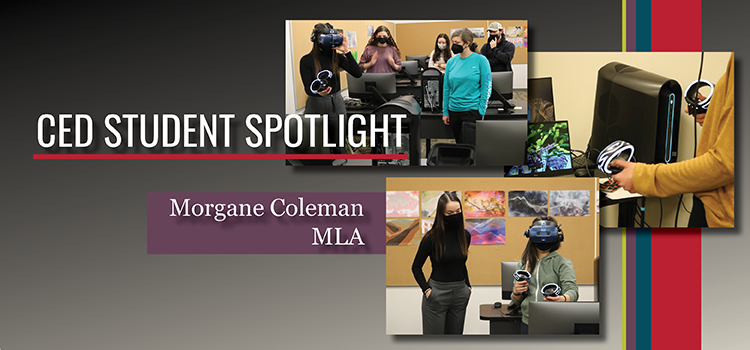MLA Student Morgane Coleman Leads the Way for VR in the CED
 Master of Landscape Architecture student Morgane Coleman is leading the way with incorporating
virtual reality (VR) technologies into the classroom in the College of Environment
and Design. Her efforts are a part of the Epic MegaGrant received by Dr. Jessica Fernandez.
Students in the Advanced Graphics class received a taste of what’s to come by re-interpreting
their exploratory graphic exercises in VR. These efforts, led by Coleman, will continue
throughout the semester through various phases of design within the class ranging
from preliminary expressions through more realistic virtual experiences of their completed
site designs. We interviewed Coleman to learn more about her efforts:
Master of Landscape Architecture student Morgane Coleman is leading the way with incorporating
virtual reality (VR) technologies into the classroom in the College of Environment
and Design. Her efforts are a part of the Epic MegaGrant received by Dr. Jessica Fernandez.
Students in the Advanced Graphics class received a taste of what’s to come by re-interpreting
their exploratory graphic exercises in VR. These efforts, led by Coleman, will continue
throughout the semester through various phases of design within the class ranging
from preliminary expressions through more realistic virtual experiences of their completed
site designs. We interviewed Coleman to learn more about her efforts:
What first interested you in virtual reality?
As students, most of our design projects are primarily learning experiences and never implemented. With VR, I can bring my designs into life as if they were built in the real world and transform my digital creations into an interactive visual and audio experience, enabling me to fully immerse myself in the space. VR technology provides methods that differ from traditional hand or computer graphics and creates opportunities for me to interact with my design and further my skills. VR has given me an increased confidence in my capabilities as a designer and is a powerful visualization tool that I plan to use for my future projects.
What do you believe is the future of VR in landscape architecture?
I believe that VR will be more widely used in landscape architecture in the future because it allows designers to experience and assess their design before they are built and to make changes before costly construction begins. By being able to clearly present the information, this tool provides clients with a realistic and interactive experience that closely mimics a real experience in a space rather than trying to comprehend 2D or 3D graphics. Outside of the design process, VR is also a great tool for networking and connecting with other people inside these virtual spaces.
What advice would you give to a student interested in exploring VR for landscape architecture design and communication?
My advice to students who are interested in exploring VR is to not be intimidated. New technologies can be overwhelming and difficult at first, but the skills you obtain are worth the time that it takes to explore and understand them. More opportunities to implement this technology in design, and VR can be a tool that can advance your career as a landscape architect.
